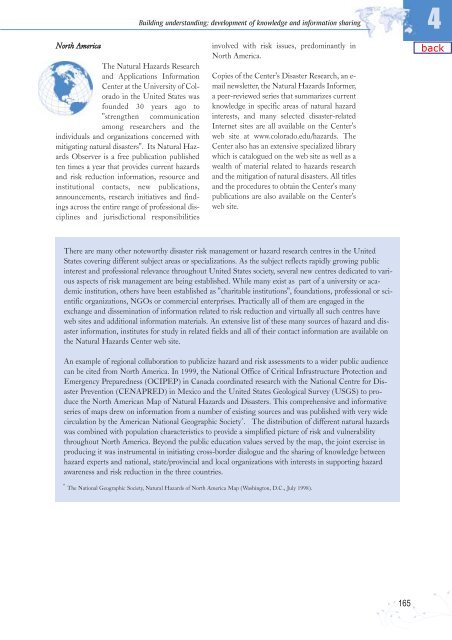Living with Risk. A global review of disaster reduction initiatives
Living with Risk. A global review of disaster reduction initiatives
Living with Risk. A global review of disaster reduction initiatives
You also want an ePaper? Increase the reach of your titles
YUMPU automatically turns print PDFs into web optimized ePapers that Google loves.
North America<br />
The Natural Hazards Research<br />
and Applications Information<br />
Center at the University <strong>of</strong> Colorado<br />
in the United States was<br />
founded 30 years ago to<br />
"strengthen communication<br />
among researchers and the<br />
individuals and organizations concerned <strong>with</strong><br />
mitigating natural <strong>disaster</strong>s". Its Natural Hazards<br />
Observer is a free publication published<br />
ten times a year that provides current hazards<br />
and risk <strong>reduction</strong> information, resource and<br />
institutional contacts, new publications,<br />
announcements, research <strong>initiatives</strong> and findings<br />
across the entire range <strong>of</strong> pr<strong>of</strong>essional disciplines<br />
and jurisdictional responsibilities<br />
Building understanding: development <strong>of</strong> knowledge and information sharing<br />
involved <strong>with</strong> risk issues, predominantly in<br />
North America.<br />
Copies <strong>of</strong> the Center's Disaster Research, an e-<br />
mail newsletter, the Natural Hazards Informer,<br />
a peer-<strong>review</strong>ed series that summarizes current<br />
knowledge in specific areas <strong>of</strong> natural hazard<br />
interests, and many selected <strong>disaster</strong>-related<br />
Internet sites are all available on the Center's<br />
web site at www.colorado.edu/hazards. The<br />
Center also has an extensive specialized library<br />
which is catalogued on the web site as well as a<br />
wealth <strong>of</strong> material related to hazards research<br />
and the mitigation <strong>of</strong> natural <strong>disaster</strong>s. All titles<br />
and the procedures to obtain the Center's many<br />
publications are also available on the Center's<br />
web site.<br />
4<br />
There are many other noteworthy <strong>disaster</strong> risk management or hazard research centres in the United<br />
States covering different subject areas or specializations. As the subject reflects rapidly growing public<br />
interest and pr<strong>of</strong>essional relevance throughout United States society, several new centres dedicated to various<br />
aspects <strong>of</strong> risk management are being established. While many exist as part <strong>of</strong> a university or academic<br />
institution, others have been established as "charitable institutions", foundations, pr<strong>of</strong>essional or scientific<br />
organizations, NGOs or commercial enterprises. Practically all <strong>of</strong> them are engaged in the<br />
exchange and dissemination <strong>of</strong> information related to risk <strong>reduction</strong> and virtually all such centres have<br />
web sites and additional information materials. An extensive list <strong>of</strong> these many sources <strong>of</strong> hazard and <strong>disaster</strong><br />
information, institutes for study in related fields and all <strong>of</strong> their contact information are available on<br />
the Natural Hazards Center web site.<br />
An example <strong>of</strong> regional collaboration to publicize hazard and risk assessments to a wider public audience<br />
can be cited from North America. In 1999, the National Office <strong>of</strong> Critical Infrastructure Protection and<br />
Emergency Preparedness (OCIPEP) in Canada coordinated research <strong>with</strong> the National Centre for Disaster<br />
Prevention (CENAPRED) in Mexico and the United States Geological Survey (USGS) to produce<br />
the North American Map <strong>of</strong> Natural Hazards and Disasters. This comprehensive and informative<br />
series <strong>of</strong> maps drew on information from a number <strong>of</strong> existing sources and was published <strong>with</strong> very wide<br />
circulation by the American National Geographic Society * . The distribution <strong>of</strong> different natural hazards<br />
was combined <strong>with</strong> population characteristics to provide a simplified picture <strong>of</strong> risk and vulnerability<br />
throughout North America. Beyond the public education values served by the map, the joint exercise in<br />
producing it was instrumental in initiating cross-border dialogue and the sharing <strong>of</strong> knowledge between<br />
hazard experts and national, state/provincial and local organizations <strong>with</strong> interests in supporting hazard<br />
awareness and risk <strong>reduction</strong> in the three countries.<br />
* The National Geographic Society, Natural Hazards <strong>of</strong> North America Map (Washington, D.C., July 1998).<br />
165

















